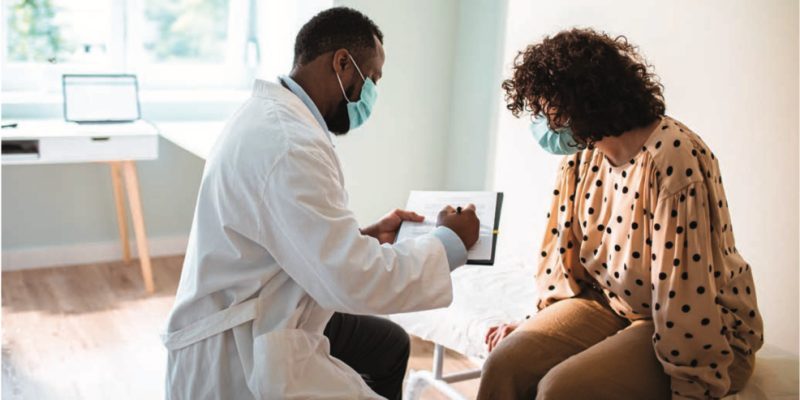By Sue Sveum
Most of us know at least one person that has — or has had — cancer. But with early screenings and better treatment options today, cancer deaths have declined by 29% over the last 30 years. While that may not be cause for a major celebration, it’s certainly reason to hope.
We asked four SSM Health oncology providers to give us some insight on what you should know about cancer.
FIRST UP: SCREENINGS
Routine cancer screening is the best way to detect cancer before any symptoms arise, according to Dana Henkel, MD, an SSM Health surgeon. “The goal is to catch a cancer early to have the best chance of treating and curing it,” she explains. “Many times, once the symptoms show up, the cancer’s already large or has spread to other parts of the body, making it harder to treat.”
Many primary care providers will refer you for a screening, but if you’re unsure, the American Cancer Society (cancer.org) recommends the following cancer screening exams:
- Breast Cancer: Annual screening mammograms for women aged 45-55. Annual or bi-annual mammograms for women 55 and older.
- Colon Cancer: Colonoscopy or a stool-based test beginning at age 45.
- Cervical Cancer: HPV or Pap test every 3-5 years for women over the age of 25.
- Prostate Cancer: Check with your doctor about pros and cons of prostate screening tests for men over the age of 50.
- Lung Cancer: Yearly CT scan of the lungs for current smokers — or those with a long-term smoking history — starting at age 55. This includes heavy smokers who have quit within the past 15 years.
Note: These are general guidelines, so if you have a family history or other risk factors for a particular cancer, you should ask your primary care provider what’s right for you.
Your primary care provider (PCP) may advise screenings earlier if you have a family history of any type of cancer.
Women with a strong family history of breast cancer or genetic mutation, for instance, may need to start getting mammograms — and possibly breast MRIs — earlier than the age of 45, says Henkel. Same with a family history of colon cancer.
One diagnostic test that has become more common in recent years is low-dose CT scans for lung cancer, according to oncologist Lisa Lepeak, MD. Unfortunately, symptoms of lung cancer don’t usually appear until the disease has reached an advanced stage, and regular chest x-rays weren’t found to be effective in extending a patient’s life. “Lung cancer screening can help catch those masses earlier,” she says. “And that can reduce the risk of dying from lung cancer by as much as 25-30%.” For long- term smokers in their 50s or older — who are at a higher risk for lung cancer — the screening may be covered by insurance.
While routine screenings are extremely important, Lepeak explains that it’s not uncommon for cancers to be discovered as a result of diagnostic testing ordered by your primary care doctor, or even a visit to the ER. “Sometimes people go in for one symptom, such as a cough,” she says, “and something else is discovered.”
WHAT TO EXPECT IF YOU’VE BEEN DIAGNOSED WITH CANCER
After any cancer screening, the report will typically go back to the ordering physician, most often the PCP. Even if the order comes through the ER, the report will go to both providers. “Primary care providers are key people in this process,” stresses Lepeak. “They’re generally the first to have that hard conversation with the patient because of their longstanding relationship. They know them.”
At this point, several things are set in motion, and your care becomes a collaborative process.
Behind the scenes is the Tumor Board: A team of providers that will review the specifics of the cancer diagnosis. According to Lepeak, the board typically consists of a medical oncologist, surgeon, radiologist, radiation oncologist, pathologist and nurse navigator who discuss the patient’s specific cancer and best chance for treatment options.
“Cancer care is highly collaborative, involving multiple specialists,” adds radiation oncologist Timothy Kruser, MD. “And it’s important to customize the care and personalize treatment within the medical support system.” The Tumor Board meeting is a brainstorming session designed to do just that — to determine the best pathway forward regarding the patient’s treatment and the doctors that will be involved.
It’s the Tumor Board’s job to gather information from a variety of sources before treatment planning begins. They first look at the staging process to determine how far the cancer has spread. That might entail ordering additional tests such as a CAT scan, PET scan, MRI or even a molecule test to detect mutations in the tumor. “From there, we ask ourselves, ‘What are the best options to serve this patient?’” says Kruser.
On the patient side of things, after diagnosis, they’ll also be contacted by a nurse navigator, who will likely become one of the most important members of their care team — helping guide them throughout their cancer journey.
SO, WHAT EXACTLY IS A NURSE NAVIGATOR?
“I’m a patient advocate — their next contact after the primary care doctor,” explains Karen Taylor, RN, OCN, adding that she’s the one charged with calling the patient after they’ve been newly diagnosed. She answers any questions they might have, explains the roles of the various doctors they may see and helps them get their appointments made.
Taylor says it would be easy to spend an hour talking about the process but feels it’s more important to ask what the patient may want to know, to find out what’s bubbling up in their mind. Too much information all at once is, well, often too much to digest. “I’d rather ask, ‘What questions do you have?’” she says. “That way I can meet them wherever they are in that moment and help them from there.”
At this point, the patient already knows that a test was performed and something suspicious has shown up. They’ve been referred to oncology and a biopsy or additional tests may have been ordered. While waiting for further results, Taylor says some will ask if they have cancer and she tells them that the doctors are treating it like it’s cancer — but we don’t really know yet.
“I’m very honest, but I don’t try to provide false hope or pat answers,” she explains, adding that she stops short of answering direct questions related to a patient’s mortality or time left. That’s something better discussed with their physician.
Taylor tells patients to call her with questions anytime throughout their journey, and she’ll find the answers. Because she works with the entire team, after writing up her notes, she can add information to the patient’s chart — or contact another provider directly with patient questions, concerns, or changes in their pain, side effects or overall condition.
Meanwhile, the first appointment that Taylor helps them schedule is with a medical oncologist, such as Lepeak. “I’m the first person they see after their primary,” says Lepeak, adding that her job includes being the point person for her patient’s care.
“At our first meeting, we’ll go through the scans together,” she explains. “I’ll show them the images, point out exactly where the cancer is and discuss standard treatment recommendations based on the type, stage and location of the cancer.”
Together, they’ll discuss the next steps. While conservative treatments are usually the preferred option, depending on the circumstances, other treatments or even clinical trials might also be considered. If chemotherapy is required, she’ll manage their treatment. In other cases, she’ll refer them to a surgeon or radiation oncologist, sometimes administering chemo after those treatments are completed. Either way, Lepeak says she follows them (and their care) long-term, always discussing which options make the most sense for them.
WHAT IS THE TREATMENT PROCESS LIKE?
You’re probably familiar with the most common cancer treatments: chemotherapy, surgery and radiation — or some combination of the three. Customizing cancer treatments is one of the biggest advancements in cancer over the last decade, according to Henkel. In the past, cancer treatment used to be “one- size-fits-all,” but now treatments can be tailored to target each cancer specifically and that patient. “Just like no two snowflakes are alike, I tell my patients that no two cancers are alike,” she explains, “so I don’t just treat cancer, I treat their specific cancer.”
Henkel says when she first sees a new breast cancer patient, for instance, she’ll spend nearly an hour going over their cancer diagnosis along with the next steps. “It can certainly be overwhelming and exhausting for the patient,” she admits, “but I want to ensure their treatment plan is the right fit.”
Radiation treatment has also evolved. “There are several cutting-edge treatments under the umbrella of radiation,
all used for different purposes,” says Kruser. “Our goal is to find the most effective and gentle treatment option possible.” Two of the most common are external beam radiation and intensity-modulated radiation therapy (IMRT), which he says is used to target a particular cancer, such as prostate or head and neck cancers, adjacent to sensitive organs.
With IMRT, curved beams can zero in on the affected area, bypassing other organs. “Another option is radio surgery, which provides very high doses of radiation to a small region — mimicking surgical [removal] in a non-invasive way,” explains Kruser. “We’ve been using it increasingly for brain and lung cancers.”
And what if the patient wants to be more conservative or aggressive with their treatment? “When presenting the treatment options, we respect patient autonomy, but want to give them the best option,” says Lepeak.
The provider’s role, according to Kruser, is to be an advisor who can bring additional insight and special medical knowledge to the case. “But we let the patient know that they’re the boss,” he stresses. “If a patient refuses one option, we go with the next best.” Sometimes the patient needs to ask themselves if their quality of life will be affected by a treatment necessary for a greater quantity of life. And a 40-year-old may well have a different response than an 80-year-old.
The providers will continue to work together along a patient’s journey through treatment and follow-up, with the nurse navigator bringing it all together. “When someone is struggling with side effects or pain, I’m usually the first to hear about it,” Taylor explains. “I’ll pass on that information, then focus on helping them to better handle their pain.”
One important element in cancer care that’s often overlooked is palliative care, says Lepeak.
So, what does palliative care look like for a cancer patient? “It’s a way to manage symptoms associated with cancer and cancer treatment to help make every single day be the best they can have — through supportive care and coping mechanisms,” says Lepeak.
“Palliative care focuses on treating physical symptoms while providing emotional support, Taylor adds. That’s why the palliative care team may include a physical therapist, social worker, psychiatrist or psychologist.
Physical pain can often be controlled by adjusting a medication or dosage. And according to Kruser, radiation can also be used to help maintain quality of life, by minimizing symptoms of certain cancers like bone or metastatic disease.
But emotions can be a little trickier. “I feel incredibly privileged to step into a patient’s life when they’re feeling vulnerable and afraid,” says Taylor. “We can’t always make the symptoms go away, but what I can do is make you feel better today.”




